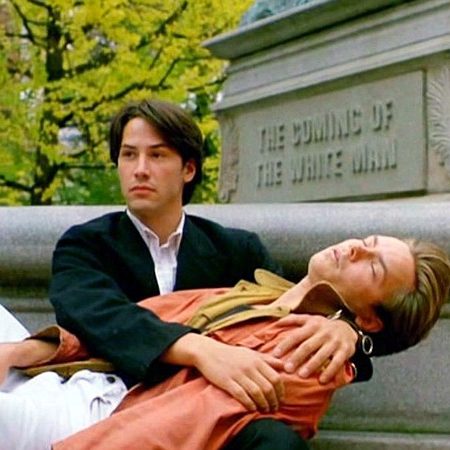No performer can drain the affect from her voice as quickly as Laurie Anderson. Besides its formidable rhythmic accomplishments, Heart of a Dog is inseparable from her flat, pensive, Midwestern tone. This brief meditation on death has a lovely shimmer; in a career spent weighing the import of sentences, Anderson finds the right visual correlative. The glance can be as unforgettable as the stare. The pause is strategy, not tactics. As she says herself, “It was just. The way, you know. Things have to be.”
Viewers familiar with the ethos of late Godard will like Heart of a Dog (what a fine double feature it and Goodbye to Language would make, especially if Anderson had titled her doc Hello, Language!). This assemblage of narrative, Anderson’s own music (her synth patches and violin as familiar as an aunt’s perfume), animation, nature stills, and free association delights in its own ephemerality. Reminiscing about her beloved rat terrier holds Heart of a Dog together – talking about her, not Lolabelle herself. A Wittgenstein passage dropped later in the film is key: matter doesn’t exist until humans describe it. In the beginning was The Word. In the middle and end too. A musician who played piano as well as I can and recorded a “pretty good” Christmas album, Lolabelle went blind in her old age, finding comfort by walking along the shore: the only time, Anderson says, Lolabelle could walk without fear of bumping against someone.
If Heart of a Dog is “about” anything, it’s dread. After 9-11, Anderson’s beloved Manhattan became the beta test for the surveillance state. The terrorists came from the air. Fans will remember the most prescient of her songs, 1982’s “From the Air,” in which the voice of a pilot prepares passengers for a fatal crash landing (“We are all. Going down. Together.”). Inversely proportional to the terrifying accumulation of instruments is Anderson’s stillness. This is the time. This is the record of the time. Records of the time demand ruthlessness. Lolabelle commanded Anderson’s love; her mother commanded her curiosity. “I’m going to see my mother, and she’s dying, and I don’t love her,” she says about those hospital visits. She remembers how the smell of medicine and burnt skin disgusted her. While I laud Anderson’s eschewing of the usual my-poor-mom bathos, it’s the only sequence in which her manner turns precious, directing attention to its preciousnesss. But just when the film threatens to curdle Anderson’s score mediates.
Which brings me to the indelible part of Heart of a Dog. With a series of albums culminating in 1989’s Strange Angels, Anderson wrote music for her wry monologues that flirted with the ethereal. The music wasn’t accompaniment; by the end of her first decade she was writing theoretical pop high on hooks that a child can memorize (as several acquaintances have claimed). The songs had a there/not there aura; if the voices in your head were set to music, they’d sound like Anderson. To find a filmed correlative for this material and compose sturdy music. As if to suggest her divided allegiances, Heart of a Dog ends with “Turning Time Around,” a 2000 song written and sung by none other than Lou Reed. She never mentions her ex-husband. Why should she? Death walks among us.


One thought on “‘Heart of a Dog’ – a shimmering meditation on death”